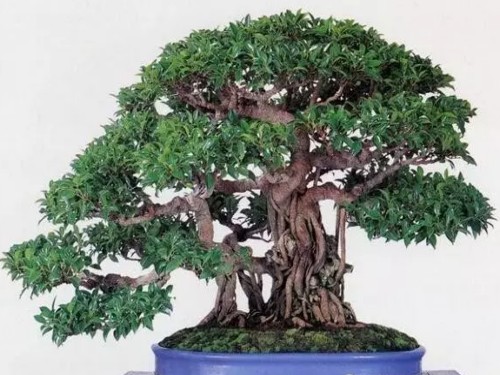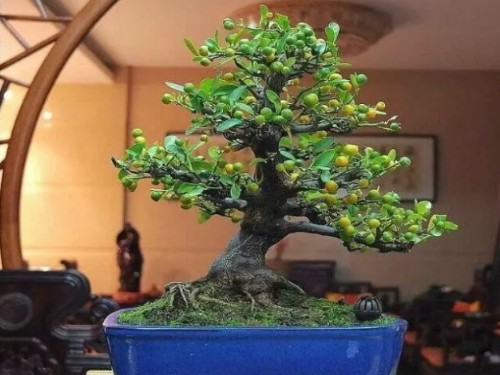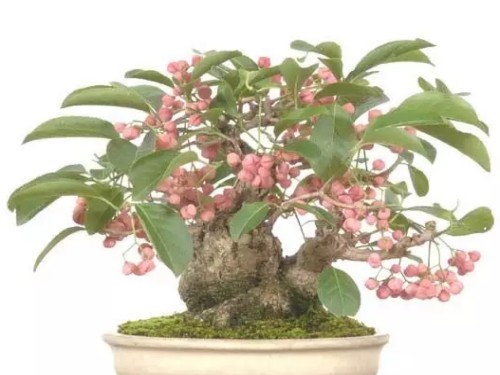What if the leaves of banyan bonsai turn black?
Banyan tree can effectively remove formaldehyde, toluene, xylene, benzene, nitrogen oxides and ozone in volatile organic compounds. The ability of absorbing dust is strong, which can increase the temperature of indoor air very well. This species has a large crown, dense branches and leaves, young trees are often potted indoors to watch, old piles do bonsai, leaves and air roots can be used as medicine. The common types of banyan bonsai are: ginseng banyan bonsai, air root banyan bonsai, stump banyan bonsai, miniature banyan bonsai and so on.
Banyan tree is a kind of plant with strong vitality and strong plasticity, which is often appreciated by potted plants, but sometimes banyan tree has some problems that affect its ornamental ability, such as blackening of leaves. The banyan tree has more leaves and likes the humid environment. Improper maintenance can easily lead to the phenomenon of yellowing and blackening of leaves. The main reason is that they are watered too often, fertilized too much, lack of light and so on. So, what is the reason for the blackening of banyan bonsai leaves? what about the blackening of banyan bonsai leaves? The following editor introduces to you several reasons and solutions that lead to the blackening of banyan bonsai leaves!

1. The temperature difference is large.
The banyan tree is suitable to grow in an environment with small temperature difference between day and night, and the environment of wearing leather jacket and gauze at noon is not suitable for the growth of banyan tree at all. When the temperature difference is more than 10 ℃, there will be a large area of yellow leaves and black leaves. Therefore, in the usual maintenance process, the potted plants should be placed in a ventilated and transparent position and shaded in time in summer.
2. Overwatering
If the root system of a banyan tree is damaged, it can be excavated from the soil, put it in a well-ventilated place, cut off the rotten root system, soak or sprinkle the root system with 500-fold carbendazim, and then leave the trunk. It is best to trim the branches and leaves on the plant, change the basin, bury all the roots in the sand (the sand is slightly wet), or you can cover the white bag and place the dark astigmatism for ten and a half days. Pay attention to the temperature above ten degrees and it will come back to life.
Improper water does great harm to the banyan tree, too much watering or high environmental humidity will cause the root system of the banyan tree to rot and cause a large area of fallen leaves. The cultivation of banyan trees in the north is more difficult, the humidity in the family should be controlled well, and too low humidity will also cause the leaves to blacken.
3. Improper fertilization
The banyan tree likes fertilizer, but the times of fertilization or more will do harm to the growth of the banyan tree. The light leaves are yellow and the heavy ones are rotten roots. During the growth period of the banyan tree, the amount of fertilizer varies according to the season, and fertilization is reduced or not in winter. Once a month in other seasons, choose to use thin fat and water, mainly to class fees, rather light than thick.
4. Diseases and insect pests
The main diseases and insect pests of banyan tree are: aphids, red spiders, scale insects and so on. When diseases and insect pests occur, the plants will be damaged to varying degrees, resulting in root rot or damage, resulting in yellowing leaves. When the leaves of the plant turn yellow, check the growth of the roots to see if there are dead roots, rotten roots, root injuries and so on. Spray chemicals in time for prevention and control.
5. Freezing injury
The black leaves of the banyan tree may be due to the fact that the temperature is too low during the winter and the leaves are blackened by freezing. Take off the frozen leaves and wait for the new leaves to grow. The ambient temperature of potted banyan trees during the winter should be kept at 10 to 15 degrees, and watering should be reduced appropriately. Move the banyan tree with blackened leaves to a higher temperature environment for nursing and breeding. When the spring temperature is above 25 degrees, it will grow new branches and leaves. If the temperature is too low and the time is long, there will be no vitality.
6. The environmental pollution is dirty
The leaves of banyan trees can not be clean in places where there is more coal or dust, and sometimes they will be so dirty that they will turn black. In this case, just put the potted plants in a clean and ventilated place, and then wash the leaves with a soft cloth dipped in water.
[warm Tip] Banyan tree Xiyang, should be placed in the outdoor sunny place to let it bask in more sunshine, do not often water, pay attention not to stagnant water, otherwise the root is easy to rot, in the growing period can be properly trimmed in order to shape later.
Time: 2019-05-31 Click:
- Prev

Conservation method of bonsai of orange in Jindou Mountain
Jindou mountain tangerine is a kind of tree. It is not only a wild plant, but also can be cultivated artificially. It is a characteristic plant with many effects and functions. The fruits and leaves of this plant can be used as medicine to treat a variety of human diseases. In recent years, mountain tangerine has become the most popular tree species in Lingnan, not to mention its advantages.
- Next

How to raise bonsai well
Although bonsai is beautiful, it is difficult to maintain its shape and even life without careful management and maintenance in the later stage. I have summed up the main reasons for the problems as follows: 1. The drying and humidity of watering is not well grasped, and the most important point in maintenance is watering. General plants should see dry and wet (not dry or watered).
Related
- Fuxing push coffee new agricultural production and marketing class: lack of small-scale processing plants
- Jujube rice field leisure farm deep ploughing Yilan for five years to create a space for organic food and play
- Nongyu Farm-A trial of organic papaya for brave women with advanced technology
- Four points for attention in the prevention and control of diseases and insect pests of edible fungi
- How to add nutrient solution to Edible Fungi
- Is there any good way to control edible fungus mites?
- Open Inoculation Technology of Edible Fungi
- Is there any clever way to use fertilizer for edible fungus in winter?
- What agents are used to kill the pathogens of edible fungi in the mushroom shed?
- Rapid drying of Edible Fungi

